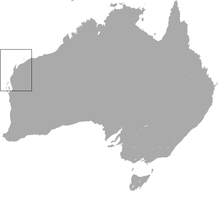Rufous hare-wallaby
| Rufous hare-wallaby | |
|---|---|
 |
|
| Mammals of Australia, Vol. II Plate 57 | |
| Scientific classification | |
| Kingdom: | Animalia |
| Phylum: | Chordata |
| Class: | Mammalia |
| Infraclass: | Marsupialia |
| Order: | Diprotodontia |
| Family: | Macropodidae |
| Genus: | Lagorchestes |
| Species: | L. hirsutus |
| Binomial name | |
|
Lagorchestes hirsutus Gould, 1844 |
|
 |
|
| Rufous hare-wallaby range (blue — native, red — introduced) |
|
The rufous hare-wallaby (Lagorchestes hirsutus), also known as the mala, is a small macropod found in Australia. It was formerly widely distributed across the western half of the continent but is now confined to Bernier Island and Dorre Island Islands off Western Australia. It is currently classified as vulnerable.
The rufous hare-wallaby has rufous-grey fur and is the smallest hare-wallaby. It is a solitary nocturnal herbivore that feeds on herbs, leaves and seeds. It is currently being reintroduced to mainland Australia, notably in the Tanami Desert in the Northern Territory.
The species was first described by John Gould (1844) in The Mammals of Australia.
Four distinct subpopulations of this species have been described as subspecies, especially with regard to their conservation status. Estimates of these island colonies numbers were between 4,300 and 6,700 in 1994, the environmental conditions cause fluctuations in the total number of animals.
Two possible subspecies are found in range restricted to islands near Western Australia.
The fourth is an unnamed subspecies that has been conserved by relocation.
For the Anangu, or Aboriginal people, the Mala or 'hare wallaby people' are important ancestral beings. For tens of thousands of years, the Mala have watched over them from rocks and caves and walls, guiding them on their relationships with people, plants and animals, rules for living and caring for country. Mala Tjukurpa, the Mala Law, is central to their living culture and celebrated in story, song, dance and ceremony.
...
Wikipedia

